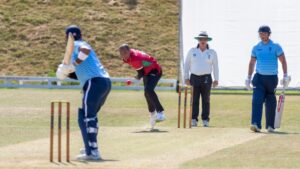Cricket Workout Plans for Bowlers Probably one of the most stressful jobs in cricket, bowling requires a perfect combination of strength, agility, endurance, and accuracy. A successful bowler needs to manage the physical and mental challenges of the long spells, explosive deliveries, and high-pressure moments. This article takes you through an effective workout plan designed by bowlers themselves, including exercises in type, strength training, cardio, and flexibility routines that are essential for peak performance.
- Identify the mechanical requirements of bowling
Bowling involves dynamic movement and therefore places immense tension on muscles, joints, and tendons. These tend to be on the shoulders, lower back, legs, and core muscles since they are constantly called to explosive action. An appropriate exercise program for a bowler will look into the following:
Develop strength on the upper body in order to facilitate quick action by the arm and accelerate its speed.
Stabilize the core in order to improve balance and reduce chances of injury.
Build lower body power to explode out of the crease for explosive speed
Condition for cardiovascular endurance to maintain their performance under long spells of bowling
Flexibility with the aim of reducing and preventing injuries, as well as enhancing mobility
- Fundamentals of Strength Training
Strength training comprises the backbone of every single bowler’s fitness. Strong muscles provide strength as well as stability for sending ball after ball with consistently fast speed.
Upper Body Strength
The shoulder, arm, and back are all important parts of the bowling action. These exercises would help to build upper body strength and arm rotation.
Dumbbell Shoulder Press. This exercise targets the deltoid muscles, which is an important muscle for arm rotation when bowling. Do 3 sets of 10-12 reps with a moderate weight.
Pull-ups: Pull-ups are good to strengthen the lats, shoulders and biceps. They help bowlers in developing arm speed and keeping control. Do 3 sets of 8-10 reps.
Seated Rows: Strengthening the back helps bowlers improve control over their line and length. Do 3 sets of 10 reps for upper body balance.
Core stability and strength

The core stabilizes the entire body, especially during delivery. It is the key to posture and reduces stress on the back.
Plank Variations: Regular planks, side planks, and inverted planks are a must for core stability. Hold each position for 30-60 seconds, repeat 3 times.
Russian Twist: This exercise improves rotational strength, which is important for the bowling action. Perform 3 sets of 15 reps on each side.
Medicine Ball Slams: These are going to build some explosive strength in the core. Complete 3 sets of 10-12 reps.
Lower body power
Lower body strength, in general, and leg strength specifically are what provide strength and balance for a bowler in order to push off of the crease.
Squats: Just doing the standard squat works your overall leg strength and endurance. Do 3 sets of 12-15 reps, form is way more important than how heavy you can lift.
Lunges: Forward, reverse, and side lunges are crucial for fast bowlers for balance and flexibility. Do 3 sets of 12 reps on each leg.
Box jumps: This will develop explosive power for quick approaches. Try to do 3 sets of 10 reps.
- Speed and Agility Training
Bowlers, especially fast bowlers, have to be explosive at the crease. Agility training develops coordination, balance, and speed Cricket Workout Plans for Bowlers play important role.
Sprinting Drills: Shuttle runs or sprint intervals can be an imitation of the stop-go motion of a bowler. Do 10-15 meter shuttle run for 10-15 seconds with short breaks in between runs. Do 6-8 sets.
Ladder drills: Agility ladder drills are perfect for footwork, which is key to a stable and controlled ball delivery. Do 3-5 stair exercises with quick foot movements.
Bounding: Bounding drills are designed to strengthen the legs and stabilise them. Do 3 sets of 20 meters.
- Endurance training
A bowler needs endurance, particularly if there is more than one over. Cardiovascular endurance exercises help a cricketer keep energy alive and efficient for long periods of time.
Long distance running: Running 2-3 km at a steady pace, done 2-3 times a week, helps build endurance without tiring the muscles.
High Intensity Interval Training (HIIT): HIIT exercise, like 30 seconds of intense activity followed by 30 seconds of rest, boosts immunity and enhances cardiovascular fitness. It is recommended that the whole session lasts for approximately 20 minutes.
Rowing machine or bicycle: The low-impact endurance exercise includes rowing or cycling. Try to perform these exercises for about 20-30 minutes at moderate pace.
- Stretching and movement exercises
First is flexibility. Injury prevention needs to be considered first of all. In fast bowling, the primary areas which are affected through overuse are the shoulders and the lower back.
Dynamic stretching: Dynamic stretches to warm the body up involve leg swings, arm circles, torso twists, which enhance flexibility and prepare muscles for an activity.
Static Stretching: Perform static stretches after exercise to improve range of motion. Focus on the hamstrings, quads, hip flexors, shoulders, and lower back. Hold each for at least 30 seconds.
Foam rolling: Foam rolling helps to alleviate muscle soreness and help bring blood flow to different parts of the body. More time on the quads, hamstrings, calves, and back are encouraged.
- Week sample training program for bowling
Here is a week training program sample that captures everything mentioned above for the bowler.
Exercise focus of the day
Leg strength training (upper body): Dumbbell shoulder press, pull-ups, seated rows
Tuesday Speed and Agility: Ladder drills, sprinting drills, bounding
Wednesday Strength Training (Lower Body): Squats, lunges, box jumps
Thursday Endurance Training: Long distance running or HIIT session
Friday Core Strengths: Plank Variations, Russian Twists, Medicine Ball Slams
Saturday’s rest and recovery
Sunday Flexibility and Mobility: Dynamic stretches, static stretching, foam rolling
- Recovery and Nutrition
Recovery is just as important as the Cricket Workout Plans for Bowlers. Regular stretching, foam rolling, and proper rest between workouts help the muscle repair and become stronger. A proper diet is a must for maintenance of performance, such as foods with lean proteins, healthy fats, complex carbohydrates, and vitamins and minerals.
Protein helps the muscles in recovery and building; food sources are: lean meats, eggs, beans and milk.
Carbohydrates: provide energy for a high-intensity effort; Emphasize whole grain foods, fruits and vegetables.
Healthy fats: they help in the production of hormones and providing energy; Avocados, nuts, seeds and olive oil are examples
Hydration: The appropriate physical performance and mental attention of the bowler are connected to staying hydrated.
- Attitude of the bowler
Bowling is quite mentally demanding, too. It needs concentration and flexibility. Regular practice, visualization, and mindfulness exercises will help the bowler better handle stress and increase his or her concentration level in games.
Conclusion
Bowling Cricket Workout Plans for Bowlers requires very much the physical aspect in addition to the psychological strain, and if carried on with exercise, this actually makes a bowler really strong, agile in nature, endurance, as well as flexible, because once they take up these types of exercises, one sees that there is enhancement or improvement for athletes about different areas which help perform even more consecutively in the game, reduce injuries risk, and perform according to their skill in that sport. Bowlers training would definitely allow them success on the bowling field through adequate diet, recovery time.
Also read Sunil Gavaskar Salary as Commentator: The Cricket Icon that Transformed into the Iconic Voice
